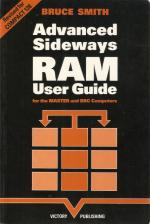
Beebug
 1st November 1986
1st November 1986
Categories: Review: Book
Author: Bruce Smith
Publisher: Victory Press
Machine: BBC B/B+/Master 128
Published in Beebug Volume 5 Number 6
Will this latest book by Bruce Smith live up to its title and delve deep into the inner workings of sideways RAM? Our own expert in this field, Bernard Hill, gives his considered view.
Advanced Sideways RAM User Guide (Victory Press)
With a book on sideways ROMs and RAMs already on the market by this author ("The BBC Micro ROM Book" - see review in Beebug Vol. 4 No. 3) the immediate question is "so what's different about this one?". A glance at the subtitle ("for the Master and BBC Computers") gives a clue. In fact this book is badly subtitled - there is precious little for the BBC micro user: throughout the text the examples are aimed directly at the Master without any warning - Welcome discs, Private RAM, *SRLOAD etc., and the programs are wrongly said to be Basic II compatible (the vast majority use 65C02 assembler instructions). And while we're on the negative side let me purge myself of the book's most annoying trait: it's been word processed on a daisywheel printer without a distinctive figure """, so every single occurrence of this number shows a letter "1" overprinted with an up-arrow ": totally distracting when reading. In fact the whole book has the taste of inadequate preparation and proof-reading. Printing errors are common, (page 133 even contains a typed-in proofreader's comment!), the index is quite inadequate (no entry for "memory", "load", "link"...), and occasionally there are minor factual inaccuracies. To call it a "User Guide" is also rather misleading as it is in no way an "official" book, and "Advanced Sideways RAM Tutorial" might have have shown better its strengths.
The first chapter is the usual difficult compromise in addressing both beginner and expert. The real core of the book is contained in chapters 2 to 15, and 5 appendices. Chapter 2 is a clear explanation of the sideways header, and is an expanded 'Master' version of the corresponding chapter of the earlier book. With chapters 3 to 5 we have a much fuller explanation than previously of the notion of service calls, and in particular HELP and command interpreters, (with clear lists of new service calls particular to the Master). The order of the previous volume is much improved here, and the inclusion of a chapter on defining your own OSBYTE and OSWORD calls (Chapter 6) is an enlightening divergence from the standard approach.
A short chapter on extended vectors (5 pages!) is followed by a round-up of other service calls, and Chapter 9 is a very nice addition on extending CONFIGURE and STATUS options via a sideways ROM. A brief examination of auto-booting is followed by a much-too-short chapter on workspace: difficult enough on the BBC, but with all the hidden workspace on the Master 7 pages is not really enough! The very clear chapter on the Rom Filing System contains essentially the same RFS formatter as the earlier volume and chapters on Languages and Error Handling are very clear.
Bruce has improved over the earlier book in that he has discarded the soon out-of-date software and hardware reviews and expanded the listings to 25 very clear programs. Whether this book is for you very much depends on what else you have: the proficient SWR programmer with all the Master User Guides will find little of use, but for most lesser mortals the collection of programs together with list of new OSBYTE/OSWORD service calls in one volume might well save the £50 on User Guides alone. Once you get over the unpolished style of the book it makes fascinating and challenging reading.
Scores
BBC B/B+/Master 128 Version| Overall | 84% |


